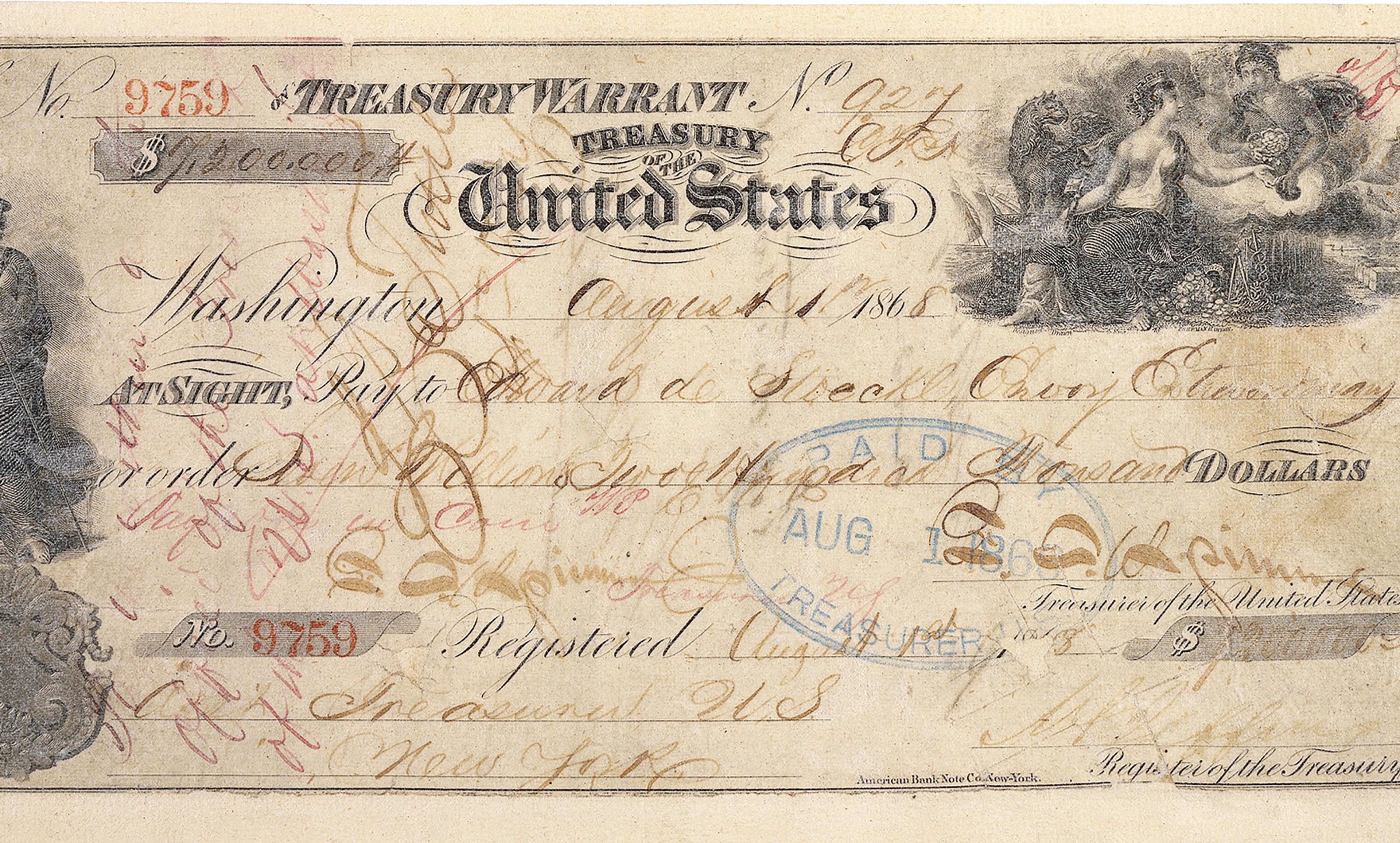Detail from the 7.2 million dollar check used to purchase Alaska in 1867. Courtesy Wikipedia
Though it is not often thought of as a commodity, sovereignty resembles one in that it can be bought and sold. Indeed, the purchase of sovereignty was a primary vehicle of American expansion. In a series of treaties that helped create the United States of today, governments operated just like a business, buying and selling their jurisdiction through mergers and acquisitions that would make even today’s tycoons envious. The Louisiana purchase from France in 1803 and the Alaska purchase from Russia in 1867 are the most famous sales of sovereignty, but there are many other deals. In 1819, Spain sold sovereignty over Florida for $3 million; in 1845, $7.5 million of debt relief bought Texas; in 1848, $15 million to Mexico transferred titles to rule California, New Mexico and Utah; in 1854, Arizona came into the US fold for $10 million. The United States purchased jurisdiction over the majority of its land.
If one is to examine more recent history, the list of precedents could easily expand to include Spanish sales of the Philippines and Puerto Rico in 1898, as well as the Danish sale of the US Virgin Islands in 1917. More recently, such a list could also include an infamous portion of Cuba, where, according to the State Department, the US leases jurisdiction and control over the Guantánamo Bay Naval Station from Cuba. Such transactions induced the US Special Operations Command to write in a 2008 memo that sovereignty ‘is a commodity driven by market-like forces’.
This is not just a US phenomenon either. Within the last century, Mexico, Japan, Mauritius, Nicaragua, Pakistan, Oman, Djibouti, Ethiopia, the Seychelles, Kyrgyzstan, Afghanistan, Chile and Peru have taken or given money in exchange for the transfer of jurisdiction over certain inhabitants in a given territory. Often these territories are overseas bases, but they need not be. In 2011, China agreed to increased investment in Tajikistan in exchange for sovereignty over 1,000 square km of territory in the Pamir Mountains, including some 5,000 inhabitants.
Europe and its former imperial possessions have seen some of the most creative deals in this vein, and not just outright sales. Germany leased sovereignty over Qingdao from China starting in 1898, while Britain, Russia and France did the same with various other Chinese territories. Leopold II sold Belgium and France ‘options’ to buy portions of the Congo Free State. And France made its recognition of Haitian independence dependent on debt payment over the course of the 19th century.
Today, there is one place where this idea could have unexpected application: California. It’s not as ridiculous as it might sound. The state is the richest and most populous in the union. If California were a country, its economy would be the sixth largest in the world – bigger than France’s. And as the US grows apart, Californians believe that they have less and less in common with their red-state compatriots. The possibility of secession should be taken seriously.
Whenever they appear, secession movements seem to pose insurmountable obstacles. In the case of California, these obstacles are significant. Secession would require amending Article 3 of the state’s constitution – no easy feat. It would require the approval of many of the Union’s 50 states – more than is feasible. And, not least, it would run up against the powerful Supreme Court precedent of Texas v White (1869) that proclaimed America to be ‘an indestructible union’. But there is another path forward and it lies in the force that undergirds much of the US’ claims to sovereignty over the American West: money.
None of this is to say that California would be better off as its own country. Far from it. The problem is that the idea of buying and selling sovereignty has plenty of precedent on its side. It is a loaded weapon for those who would wish to pick it up. No doubt, to say that there is a price for political control offends modern sensibilities. It doesn’t seem democratic. Yet the idea of selling sovereignty has been deemed legitimate by many governments across the world: not just Russia, Spain, Denmark and France (the counterparties to the famous US deals), but a spate of far smaller states as well. The US Congress and other world institutions have ratified all of the treaties concerning sovereign rights as commodities. Finally, even if there are many legal obstacles worldwide that prohibit secession, there are none that prohibit the marketplace in sovereignty – a once-vibrant marketplace full of sales, leases and options – from reactivating.
The idea of treating sovereignty as a commodity is a troubling one, and many world leaders embrace it when it serves them. Unless the United States and other great powers start putting clear limits to the practice – and resolve to break from history in this regard – the purchase of jurisdiction will remain an option for secessionists. California may provide a test case in the near future. The window is open.






